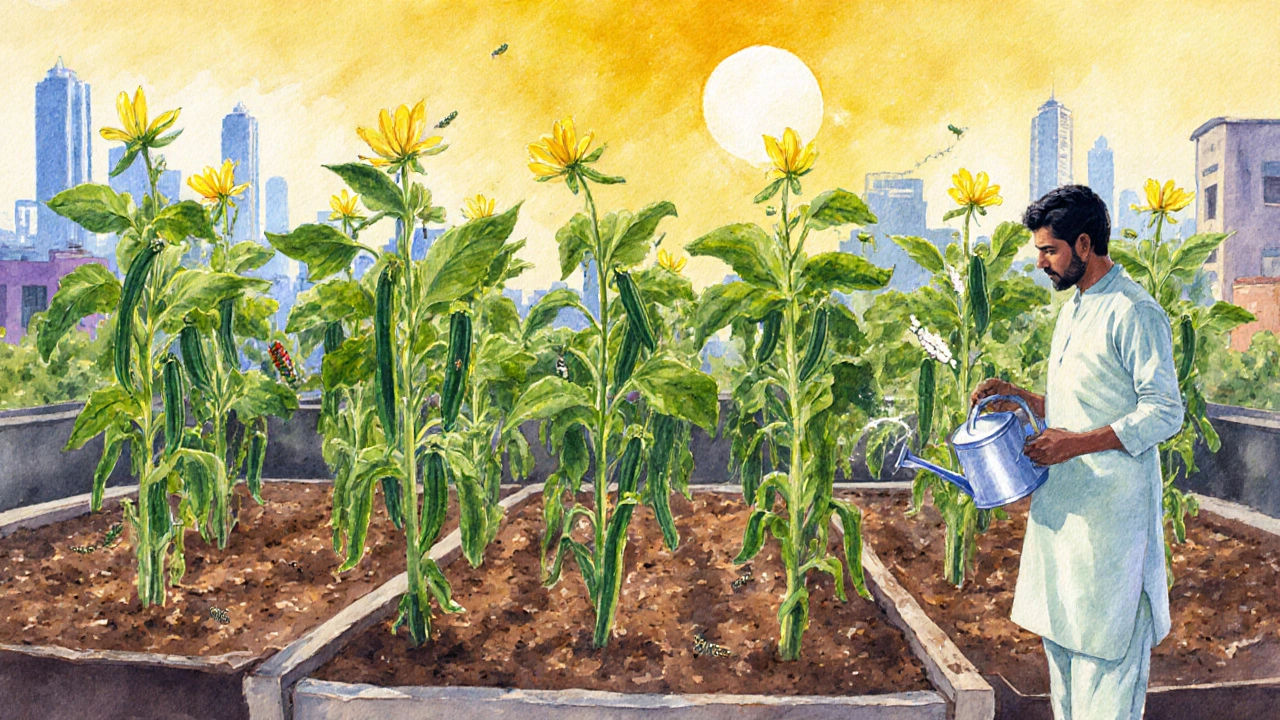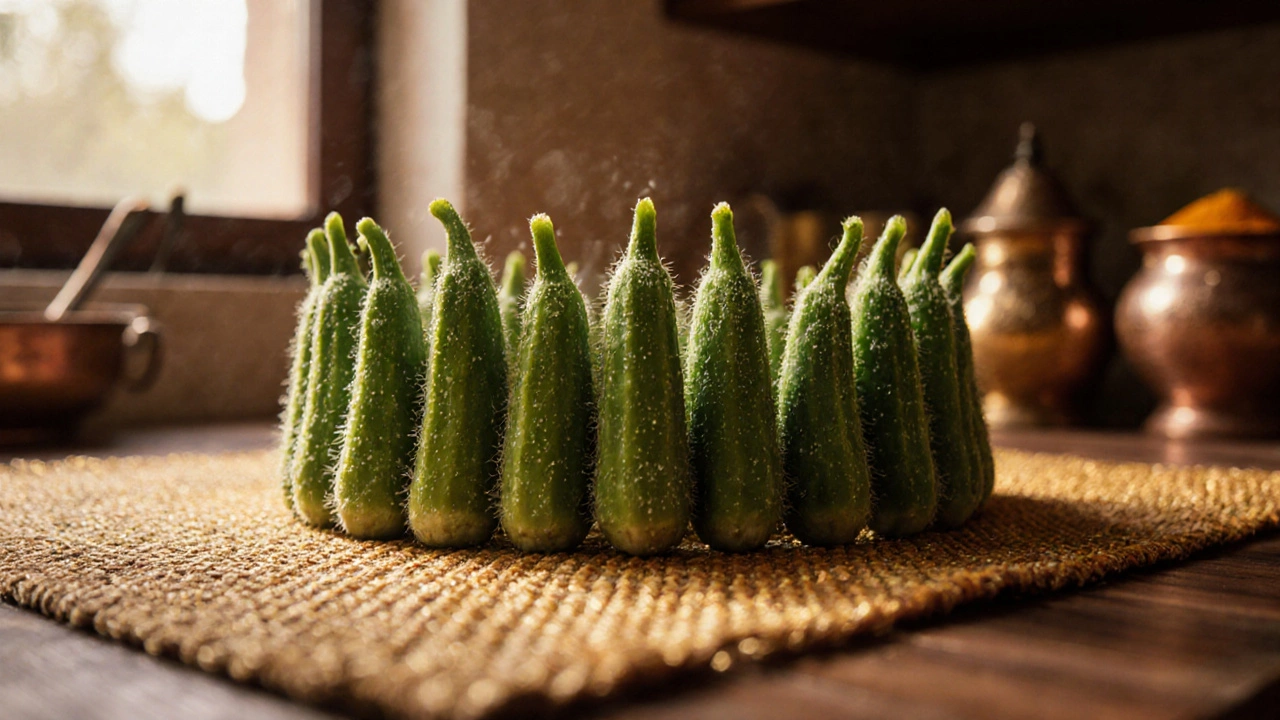Okra Growing & Nutrition Calculator
Your Okra Growing Results
Total Estimated Yield:
Estimated Fiber Intake (per 100g): g
Vitamin C Content (per 100g): mg
Health Benefits: High fiber helps regulate blood sugar; Vitamin C boosts immunity; Folate supports cell division.
Nutritional Comparison Table
| Vegetable | Scientific Name | Avg Growing Season (days) | Key Nutrient (per 100g) | Typical Indian Dish |
|---|---|---|---|---|
| Okra (Bhindi) | Abelmoschus esculentus | 50–70 | Fiber 7 g | Bhindi Masala |
| Eggplant (Brinjal) | Solanum melongena | 70–90 | Potassium 229 mg | Baingan Bharta |
| Bitter Gourd (Karela) | Momordica charantia | 60–80 | Vitamin C 23 mg | Karela Sabzi |
| Carrot (Gajar) | Daucus carota subsp. sativus | 70–110 | Beta-carotene 8285 µg | Gajar Halwa |
When you hear the phrase “queen of vegetables” in an Indian kitchen, most people instantly picture a slim, green pod that’s a staple in every household. That title belongs to queen of vegetables India - okra, known locally as bhindi. It’s not just the way it looks; its versatility, nutrition, and ease of growth make it the undisputed ruler of Indian vegetable beds.
Key Takeaways
- Okra (Abelmoschus esculentus) is popularly called the “queen of vegetables” in India.
- It thrives in warm climates, prefers well‑drained loamy soil, and can be harvested in as little as 50 days.
- Rich in fiber, vitamin C, K, and folate, okra supports digestion and heart health.
- Signature Indian dishes like bhindi masala, bhindi fry, and sambar showcase its culinary royalty.
- Common pests include aphids and fruit flies; integrated pest management keeps the crop healthy.
Why Okra Earns the Crown
Okra’s royal status isn’t a marketing gimmick; it’s earned through a mix of agronomic and cultural factors. First, the plant tolerates heat and drought better than most Indian greens, making it a reliable harvest even when monsoons are erratic. Second, its pods are quick‑growing - from sowing to first pick can be under two months, allowing multiple harvests in a single season. Finally, the taste and texture fit perfectly into the diverse spice palettes of North, South, East, and West India, turning every meal into a celebration of flavor.
Botanical Profile
Okra is a warm‑season annual herb that belongs to the Malvaceae family, scientifically named Abelmoschus esculentus. It originated in Africa but has been cultivated across the Indian subcontinent for centuries. The plant typically reaches 3‑5 feet in height, sporting large, lobed leaves and hairy stems. Each flower is a bright yellow trumpet that blossoms for a single day, later giving rise to the familiar green pods that can grow up to 12cm long.

Growing Okra in Indian Conditions
Whether you garden on a rooftop terrace or a rural plot, okra adapts well with a few simple steps.
- Soil selection: Choose well‑drained loam with a pH of 6.0‑6.8. Heavy clay holds water and can cause root rot.
- Sunlight: Plant in full sun-minimum 6-8hours daily. Okra’s photosynthetic efficiency peaks in hot, bright conditions.
- Sowing time: In most Indian states, sow seeds after the last frost, typically late March to early May. In southern tropics, a second sowing in July offers a post‑monsoon crop.
- Seed depth & spacing: Plant seeds 1cm deep, spacing 30cm apart in rows 90cm apart. This spacing ensures good air flow, reducing fungal risk.
- Irrigation: Keep soil consistently moist during germination; thereafter, water every 7‑10 days, increasing frequency during dry spells.
- Fertilization: Apply a balanced 10‑10‑10 NPK fertilizer at planting, followed by a side‑dressing of compost after the first harvest.
- Harvest: Pick pods when they are 5‑8cm long and still tender. Over‑ripe pods become fibrous and less palatable.
Following this schedule can yield 5-7 harvests per season, each producing 60‑80g of fresh pods per plant.
Culinary Royalty: How India Celebrates Okra
Okra’s mucilaginous texture is both a blessing and a challenge. Indian chefs have mastered techniques to control slime while extracting flavor.
- Bhindi Masala - a dry stir‑fry with onions, tomatoes, and a blend of turmeric, cumin, and coriander.
- Bhindi Fry (Pakora) - sliced okra dipped in chickpea flour batter and deep‑fried until crisp.
- Sambar with okra - a South Indian lentil stew where pods absorb the tangy tamarind base.
- Okra Pickle - a spicy, tangy preparation that preserves pods for months.
These dishes showcase the vegetable’s ability to absorb spices while retaining its distinct bite, reinforcing its status as a kitchen sovereign.
Nutrition & Health Benefits
Okra packs a nutritious punch without many calories. A 100‑gram serving provides:
- 33kcal
- 2g protein
- 7g dietary fiber (helps regulate blood sugar)
- 14mg vitaminC (30% of RDI)
- 31µg vitaminK (25% of RDI)
- 90µg folate (22% of RDI)
The soluble fiber forms a gel that slows glucose absorption, making okra a smart choice for diabetics. The antioxidants, especially quercetin and catechin, combat oxidative stress, supporting heart health.
Okra vs. Other Popular Indian Vegetables
| Vegetable | Scientific Name | Average Growing Season (days) | Key Nutrient (per 100g) | Typical Indian Dish |
|---|---|---|---|---|
| Okra (Bhindi) | Abelmoschus esculentus | 50‑70 | Fiber7g | Bhindi Masala |
| Eggplant (Brinjal) | Solanum melongena | 70‑90 | Potassium229mg | Baingan Bharta |
| Bitter Gourd (Karela) | Momordica charantia | 60‑80 | VitaminC23mg | Karela Sabzi |
| Carrot (Gajar) | Daucus carota subsp. sativus | 70‑110 | Beta‑carotene8285µg | Gajar Halwa |
While each vegetable shines in its own right, okra’s rapid turnaround and high fiber content give it a unique edge, especially for small‑scale or urban growers.
Common Challenges & Integrated Pest Management
Even the queen faces opponents. The most frequent issues are:
- Aphids: Tiny green insects that suck sap, leading to stunted growth. Control by spraying neem oil or introducing lady‑bird beetles.
- Fruit flies: Lay eggs inside pods, causing maggot damage. Use yellow sticky traps and practice crop rotation.
- Root rot: Result of waterlogged soil. Ensure proper drainage and avoid over‑watering.
- Powdery mildew: Fungal growth in humid evenings. Apply a sulfur‑based spray early in the morning.
Employing a combination of cultural practices (spacing, pruning), biological allies (beneficial insects), and low‑toxicity sprays maintains a healthy crop without compromising the soil’s microbiome.
FAQs
Frequently Asked Questions
What makes okra the "queen of vegetables" in India?
Okra’s fast growth, heat tolerance, high fiber content, and its central role in beloved Indian dishes combine to give it a regal reputation across the country.
When is the best time to plant okra in India?
Sow seeds after the last frost, usually late March to early May in most regions. In tropical south India, a second sowing in July takes advantage of post‑monsoon warmth.
How do I keep okra pods from becoming too slimy?
Dry‑cook the pods quickly over high heat, add acidic ingredients like lemon or tomatoes, and avoid over‑cooking. Patting the sliced pods dry before frying also reduces mucilage.
Can I grow okra in containers on a balcony?
Yes. Use a 12‑inch deep pot with well‑draining potting mix, place it in full sun, and water consistently. Space seeds 6cm apart and thin to the strongest seedling.
What are the top nutritional benefits of eating okra?
Okra is low‑calorie, high in soluble fiber (good for blood‑sugar control), rich in vitaminC and K, and supplies folate and antioxidants that support heart health.
So the next time you hear someone call a vegetable the queen, you’ll know exactly why okra wears the crown across Indian kitchens and gardens alike.

